Published on Bootsnall.com on June 20, 2012
It’s great to return from a long trip, your mind reeling from new
experiences, anxious to share everything you saw and did with family and
friends. I have a map of the world on my office wall, and one of the first
things I do is add a couple of pushpins to mark my latest “travel
conquests.”
But travel is so much more than bragging rights and pushpins on a map. The greatest gifts of travel are the people that you meet; the unforgettable characters who leave an indelible mark on your soul. My life is richer because of chance encounters with people who shared their lives with me and helped me to see the world a little differently.
Here are the stories of six of my unforgettable characters:
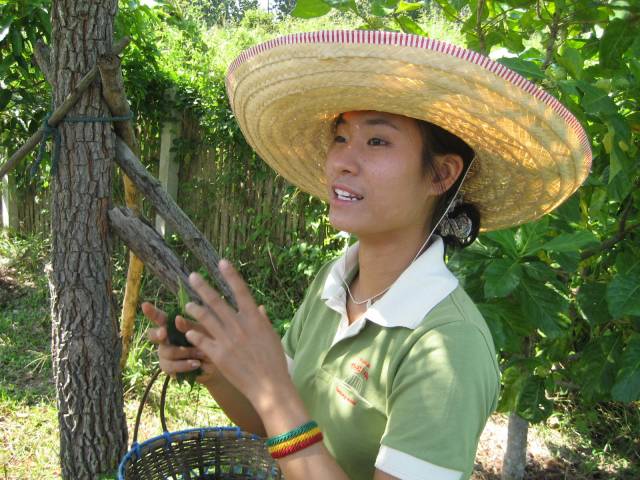
My husband and I attended a Thai cooking school in Chiang Mai taught by a young Thai woman named “Nice.” We were fortunate to be part of a lively group of food lovers, all Europeans with representation from the U.K., the Netherlands, and Spain. Nice taught us the secrets of spicy red curry paste and introduced us to the wonderful tanginess of the Kaffir lime, but she also gave us some insight into the Thai mindset. Just before we began to eat our delicious creations, one of our fellow students asked Nice for the Thai equivalent of “bon appetite.” In a classic case of Western pleasure seeker meets Eastern realist, she thought for a moment and said, “We don’t have one. We just eat when we are hungry.”
Later, Nice told us that she had recently visited Europe for the first time. Of course, we all wanted to hear her impressions. Surprisingly, one of her most astounding experiences was a visit to the Englischer Garten in Munich, a place famous for the German office workers who regularly sunbathe in the nude at lunchtime. Nice was no prude, so it wasn’t the nudity that had shocked her. What left her totally flabbergasted was that, as she put it, “The people wanted to get brown!”
She could not believe that Westerners laid out in the sun to soak up the rays, much less used “browning devices” like tanning beds and tanning creams. Watching our puzzled white faces, Nice explained that in Thailand, women routinely used whitening creams and did everything they could to protect themselves from the sun in order to be as white as possible. Young girls even aspired to work in offices when they grew up so they wouldn’t have to spend their days out in the sun! I guess it must be part of the human condition to always want what you don’t have.

Our arrival in Avallon, France was perfectly timed to visit the weekly market. We stocked up on the usual supply of olives, cheese, bread, and jambon (ham). As we strolled around town, an English-speaking Frenchman approached us and asked how we were enjoying our trip to France. Of course, we responded enthusiastically, and then he asked if we were Americans.
This was 2003 when relations between the U.S. and France had hit an all-time low, when some American restaurants changed their menus to offer “freedom fries” instead of French fries, and all French products were frequently boycotted. In fact, some of our friends had admonished us for choosing France as our vacation destination. And even though France had always been one of our favorite countries, we had to admit we felt uneasy, wondering how the French would receive us.
I gulped and confirmed his hunch that we were indeed Americans. He told us that his parents had always taught him to be grateful to the Americans for liberating France during WWII. And he went on to say that most of the people in Avallon felt the same way he did. It was obvious that this stranger had purposely sought us out to share his feelings. He clearly wanted us to know that despite the heated rhetoric of our governments, we were very welcome here in Avallon. All the fears that I harbored about being accepted in France vanished like the croissants on our hotel’s breakfast buffet table. Then the Frenchman smiled and placed his hand across his chest as he said, “My heart is always with America.”
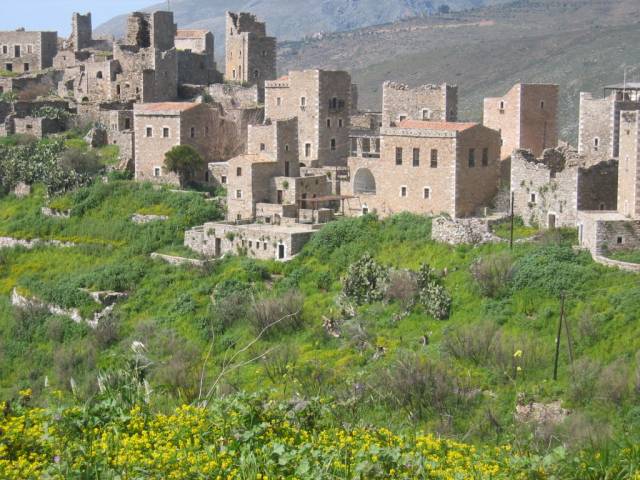
In 2006, we traveled to Areopoli, a small town in the Mani region of the Greek Peloponnese where we stayed in a 300-year old Mani tower house, a tall stone structure built for defense rather than comfort. The Mani people have a reputation as ferocious fighters, and like a Greek version of the Hatfields and the McCoys, family feuds were common here for centuries. The combative families would retreat to their tower houses and blast each other with whatever ammunition they could find. These feuds could last for decades: the longest one lasted 40 years, and in 1870, the very last feud required intervention by 400 members of the Greek military.
Unfortunately, the bloodshed continued through the Balkan Wars, two World Wars, and various civil uprisings. Just in case we momentarily forgot this history of violence, the first floor of our Mani tower house held a small military museum with a personal collection that included a proud display of two German lugers. Nevertheless, the people of the Mani were very friendly. One evening, our hostess told us that her father, Giorgio, wanted to go to dinner with us (in our car) to a good restaurant. Sure, why not? How could we turn down an 85 year-old freeloader? So off we went with Giorgio nestled in the backseat. Giorgio spoke very little English, but he was good at barking out directions like: “Left,” “Right,” and “Stop!”
The restaurant was actually quite good, and the owners treated us like family (who knows, maybe that was because Giorgio was family!). It was amazing to see all the food the old guy ordered: extra plates of spinach, French fries, tzatiki (yogurt, cucumber, and garlic), and toasted bread. He invited us to share all of his goodies, but the three of us hardly made a dent.
Dinner conversation was a bit sketchy because of the language problem, but Giorgio did let us know (via broken English and gestures) that he loved America and Americans. However, he also made it very clear that he thought George “Boooosh” was crazy for invading Iraq. (Perhaps Giorgio had seen enough violence for one lifetime.) With so little shared language, I could only reply as I often do when placed in this situation. I shrugged and sighed as I said, “Politics!” This response seemed to satisfy Giorgio, and he chuckled as he reached for his enormous doggie bag of leftovers. Apparently, he had accomplished his mission, and our meal was over. We made our farewells, loaded Giorgio into the backseat, and headed for home.
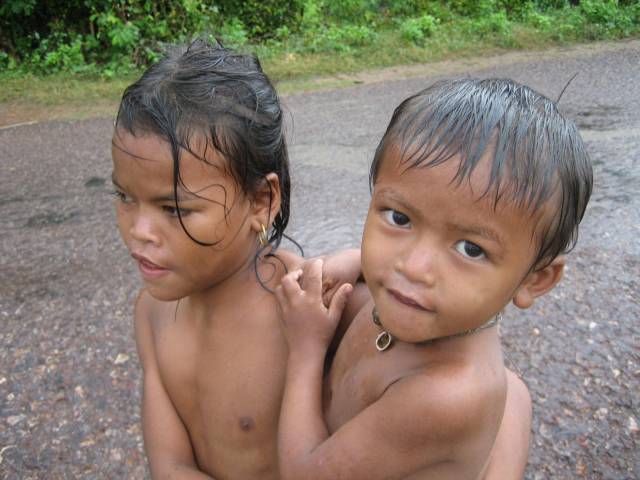
We hired Nak, a 39-year-old Cambodian tour guide, to take us to the outlying temples of Angkor Wat. He looked younger than his years, and when I asked him a question about the Pol Pot era, I never expected to hear that he had actually lived through those times. Nak explained that when the Khmer Rouge came to power, he was a young boy attending school in the city of Siem Reap with 850 other pupils. By the end of the Khmer Rouge regime, Nak was the only student to survive.
As we bumped along pot-holed roads, passing half-naked village children who stared at us from the roadside, Nak proceeded to share unthinkable stories of hardship and horrors including this one. Nak and his parents were living in a countryside commune working in the rice fields. Conditions were terrible with little food or medical attention. One day, the Khmer Rouge rounded up everyone to issue a new proclamation. An old man took this opportunity to ask the soldiers if the children could have more food. The answer given was to “follow Khmer Rouge.” The old man replied that he did follow Khmer Rouge, but he was worried because so many children (about 1 in 7) were dying. A soldier responded, “I am your boss; you are not my boss.” The old man tried again, “I know you are my boss, but the children are our future. Can’t we help them?” The soldier answered, “I am going to make an example of you.”
The soldier bound the old man’s arms and legs and cut him lightly across the throat just enough to produce a rush of blood but not deep enough to kill him. Whenever the old man lost consciousness, the Khmer Rouge soldier poured salt water on the wound to wake him up. Then, the soldier would cut him again and repeat the process. When the old man finally remained unconscious in spite of the salt water, the soldiers buried the poor man even though he may still have been alive.
At the end of our day together, I thanked Nak for telling us the story of his life, and told him how much I appreciated his willingness to talk about a time that was obviously so painful for him. Nak smiled and said, “I was a lucky boy. I am one out of 850.”
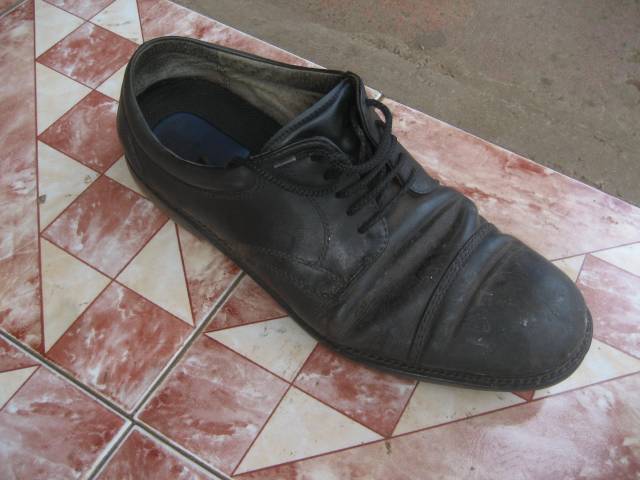
Easter Island is one of the most isolated places on earth — 2,000 miles from the coast of Chile and over 1,000 miles from Pitcairn Island, its closest neighbor. It’s hard to imagine living so far removed from the rest of the world. After spending some relaxing days admiring the enigmatic stone statues, we were doing some last minute souvenir shopping on the main drag in Hanga Roa — Easter Island’s only town — when a tall, English-speaking islander with a friendly (if somewhat toothless) smile approached us. He asked the usual questions: where we were from and how we liked the island. Eventually, he introduced himself as Jorge and then asked if he could give us $60 to buy him a pair of his favorite shoes from Payless Shoe Stores in the US!
We were startled and more than a bit suspicious of his request. But Jorge explained that while Payless would charge a fortune to ship the shoes to him, we could mail them to him for much less. He had obviously done his homework explaining that the $60 would cover the cost of the shoes ($39.99) and the shipping. He was so trusting and so willing to give us his $60 that we figured why not help the guy out? Jorge gave us his address (which simply consisted of his name and ‘Easter Island, Chile’) plus all the specifics on his shoe size (11 wide), and his preferred shoe style (Hunter Bay). He was wearing a bedraggled pair of the very shoes he wanted to replace (and he wasn’t kidding when he said he needed new ones). We were taking our shoe-buying assignment seriously, so we took a picture of his shoe just to be sure we knew what to buy.
Back home, we found the shoes exactly as he had described, packaged them up, and shipped them off to Easter Island. A few weeks later, a very happy Jorge sent us an email telling us how thrilled he was with his new Payless shoes.
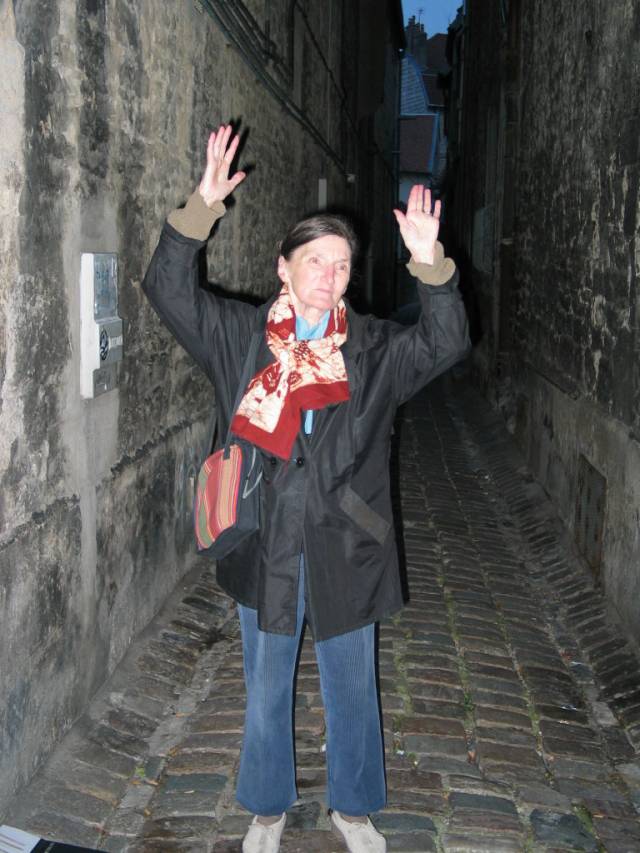
We had just visited the Resistance and Deportation Museum in Besançon, France, and our minds were reeling from powerful images of Nazi atrocities as we walked back into the city. Up ahead, we noticed an older woman taking lots of pictures of a side alley. Not ones to miss a photo op, we hurried toward her, curious to see what was so picture-worthy. The woman spoke to us in a combination of French and broken English, allowing us to piece together her story: when she was a little girl, she had escaped the Nazis by running down this very alleyway. (Unfortunately, her father was not so lucky – he was captured and died in a concentration camp.)
The whole conversation was surreal, especially after having just spent several hours pondering the stories of resistance fighters, collaborators, and concentration camp victims in the twenty-room Resistance Museum. I honestly felt as if we had stepped through a time portal into the past. This woman, who had survived ordeals we could only imagine, passionately wished peace for tout la monde (for all the world). She kissed my hand and rubbed my husband’s cheek. Then she threw her hands up into the air and said, “The sky belongs to all of us.”
All photos are courtesy of Frank Supsic and may not be used without
permission.
But travel is so much more than bragging rights and pushpins on a map. The greatest gifts of travel are the people that you meet; the unforgettable characters who leave an indelible mark on your soul. My life is richer because of chance encounters with people who shared their lives with me and helped me to see the world a little differently.
Here are the stories of six of my unforgettable characters:
The grass is always greener

My husband and I attended a Thai cooking school in Chiang Mai taught by a young Thai woman named “Nice.” We were fortunate to be part of a lively group of food lovers, all Europeans with representation from the U.K., the Netherlands, and Spain. Nice taught us the secrets of spicy red curry paste and introduced us to the wonderful tanginess of the Kaffir lime, but she also gave us some insight into the Thai mindset. Just before we began to eat our delicious creations, one of our fellow students asked Nice for the Thai equivalent of “bon appetite.” In a classic case of Western pleasure seeker meets Eastern realist, she thought for a moment and said, “We don’t have one. We just eat when we are hungry.”
Later, Nice told us that she had recently visited Europe for the first time. Of course, we all wanted to hear her impressions. Surprisingly, one of her most astounding experiences was a visit to the Englischer Garten in Munich, a place famous for the German office workers who regularly sunbathe in the nude at lunchtime. Nice was no prude, so it wasn’t the nudity that had shocked her. What left her totally flabbergasted was that, as she put it, “The people wanted to get brown!”
She could not believe that Westerners laid out in the sun to soak up the rays, much less used “browning devices” like tanning beds and tanning creams. Watching our puzzled white faces, Nice explained that in Thailand, women routinely used whitening creams and did everything they could to protect themselves from the sun in order to be as white as possible. Young girls even aspired to work in offices when they grew up so they wouldn’t have to spend their days out in the sun! I guess it must be part of the human condition to always want what you don’t have.
Americans in Avallon

Our arrival in Avallon, France was perfectly timed to visit the weekly market. We stocked up on the usual supply of olives, cheese, bread, and jambon (ham). As we strolled around town, an English-speaking Frenchman approached us and asked how we were enjoying our trip to France. Of course, we responded enthusiastically, and then he asked if we were Americans.
This was 2003 when relations between the U.S. and France had hit an all-time low, when some American restaurants changed their menus to offer “freedom fries” instead of French fries, and all French products were frequently boycotted. In fact, some of our friends had admonished us for choosing France as our vacation destination. And even though France had always been one of our favorite countries, we had to admit we felt uneasy, wondering how the French would receive us.
I gulped and confirmed his hunch that we were indeed Americans. He told us that his parents had always taught him to be grateful to the Americans for liberating France during WWII. And he went on to say that most of the people in Avallon felt the same way he did. It was obvious that this stranger had purposely sought us out to share his feelings. He clearly wanted us to know that despite the heated rhetoric of our governments, we were very welcome here in Avallon. All the fears that I harbored about being accepted in France vanished like the croissants on our hotel’s breakfast buffet table. Then the Frenchman smiled and placed his hand across his chest as he said, “My heart is always with America.”
Dinner with Giorgio

In 2006, we traveled to Areopoli, a small town in the Mani region of the Greek Peloponnese where we stayed in a 300-year old Mani tower house, a tall stone structure built for defense rather than comfort. The Mani people have a reputation as ferocious fighters, and like a Greek version of the Hatfields and the McCoys, family feuds were common here for centuries. The combative families would retreat to their tower houses and blast each other with whatever ammunition they could find. These feuds could last for decades: the longest one lasted 40 years, and in 1870, the very last feud required intervention by 400 members of the Greek military.
Unfortunately, the bloodshed continued through the Balkan Wars, two World Wars, and various civil uprisings. Just in case we momentarily forgot this history of violence, the first floor of our Mani tower house held a small military museum with a personal collection that included a proud display of two German lugers. Nevertheless, the people of the Mani were very friendly. One evening, our hostess told us that her father, Giorgio, wanted to go to dinner with us (in our car) to a good restaurant. Sure, why not? How could we turn down an 85 year-old freeloader? So off we went with Giorgio nestled in the backseat. Giorgio spoke very little English, but he was good at barking out directions like: “Left,” “Right,” and “Stop!”
The restaurant was actually quite good, and the owners treated us like family (who knows, maybe that was because Giorgio was family!). It was amazing to see all the food the old guy ordered: extra plates of spinach, French fries, tzatiki (yogurt, cucumber, and garlic), and toasted bread. He invited us to share all of his goodies, but the three of us hardly made a dent.
Dinner conversation was a bit sketchy because of the language problem, but Giorgio did let us know (via broken English and gestures) that he loved America and Americans. However, he also made it very clear that he thought George “Boooosh” was crazy for invading Iraq. (Perhaps Giorgio had seen enough violence for one lifetime.) With so little shared language, I could only reply as I often do when placed in this situation. I shrugged and sighed as I said, “Politics!” This response seemed to satisfy Giorgio, and he chuckled as he reached for his enormous doggie bag of leftovers. Apparently, he had accomplished his mission, and our meal was over. We made our farewells, loaded Giorgio into the backseat, and headed for home.
The story of Nak

We hired Nak, a 39-year-old Cambodian tour guide, to take us to the outlying temples of Angkor Wat. He looked younger than his years, and when I asked him a question about the Pol Pot era, I never expected to hear that he had actually lived through those times. Nak explained that when the Khmer Rouge came to power, he was a young boy attending school in the city of Siem Reap with 850 other pupils. By the end of the Khmer Rouge regime, Nak was the only student to survive.
As we bumped along pot-holed roads, passing half-naked village children who stared at us from the roadside, Nak proceeded to share unthinkable stories of hardship and horrors including this one. Nak and his parents were living in a countryside commune working in the rice fields. Conditions were terrible with little food or medical attention. One day, the Khmer Rouge rounded up everyone to issue a new proclamation. An old man took this opportunity to ask the soldiers if the children could have more food. The answer given was to “follow Khmer Rouge.” The old man replied that he did follow Khmer Rouge, but he was worried because so many children (about 1 in 7) were dying. A soldier responded, “I am your boss; you are not my boss.” The old man tried again, “I know you are my boss, but the children are our future. Can’t we help them?” The soldier answered, “I am going to make an example of you.”
The soldier bound the old man’s arms and legs and cut him lightly across the throat just enough to produce a rush of blood but not deep enough to kill him. Whenever the old man lost consciousness, the Khmer Rouge soldier poured salt water on the wound to wake him up. Then, the soldier would cut him again and repeat the process. When the old man finally remained unconscious in spite of the salt water, the soldiers buried the poor man even though he may still have been alive.
At the end of our day together, I thanked Nak for telling us the story of his life, and told him how much I appreciated his willingness to talk about a time that was obviously so painful for him. Nak smiled and said, “I was a lucky boy. I am one out of 850.”
Jorge’s shoes

Easter Island is one of the most isolated places on earth — 2,000 miles from the coast of Chile and over 1,000 miles from Pitcairn Island, its closest neighbor. It’s hard to imagine living so far removed from the rest of the world. After spending some relaxing days admiring the enigmatic stone statues, we were doing some last minute souvenir shopping on the main drag in Hanga Roa — Easter Island’s only town — when a tall, English-speaking islander with a friendly (if somewhat toothless) smile approached us. He asked the usual questions: where we were from and how we liked the island. Eventually, he introduced himself as Jorge and then asked if he could give us $60 to buy him a pair of his favorite shoes from Payless Shoe Stores in the US!
We were startled and more than a bit suspicious of his request. But Jorge explained that while Payless would charge a fortune to ship the shoes to him, we could mail them to him for much less. He had obviously done his homework explaining that the $60 would cover the cost of the shoes ($39.99) and the shipping. He was so trusting and so willing to give us his $60 that we figured why not help the guy out? Jorge gave us his address (which simply consisted of his name and ‘Easter Island, Chile’) plus all the specifics on his shoe size (11 wide), and his preferred shoe style (Hunter Bay). He was wearing a bedraggled pair of the very shoes he wanted to replace (and he wasn’t kidding when he said he needed new ones). We were taking our shoe-buying assignment seriously, so we took a picture of his shoe just to be sure we knew what to buy.
Back home, we found the shoes exactly as he had described, packaged them up, and shipped them off to Easter Island. A few weeks later, a very happy Jorge sent us an email telling us how thrilled he was with his new Payless shoes.
Our lady of the alley

We had just visited the Resistance and Deportation Museum in Besançon, France, and our minds were reeling from powerful images of Nazi atrocities as we walked back into the city. Up ahead, we noticed an older woman taking lots of pictures of a side alley. Not ones to miss a photo op, we hurried toward her, curious to see what was so picture-worthy. The woman spoke to us in a combination of French and broken English, allowing us to piece together her story: when she was a little girl, she had escaped the Nazis by running down this very alleyway. (Unfortunately, her father was not so lucky – he was captured and died in a concentration camp.)
The whole conversation was surreal, especially after having just spent several hours pondering the stories of resistance fighters, collaborators, and concentration camp victims in the twenty-room Resistance Museum. I honestly felt as if we had stepped through a time portal into the past. This woman, who had survived ordeals we could only imagine, passionately wished peace for tout la monde (for all the world). She kissed my hand and rubbed my husband’s cheek. Then she threw her hands up into the air and said, “The sky belongs to all of us.”
No comments:
Post a Comment